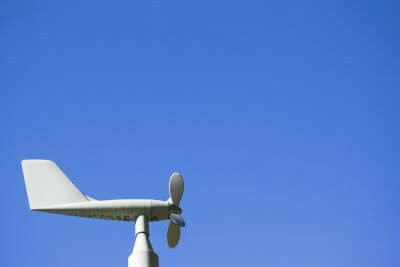What Is an Anemometer?

An anemometer is an instrument that has the functions of both an anemometer and an anemometer.
It is used to observe wind conditions because it can measure both wind speed and direction at the same time. There are many types of anemometers; the three main types being the wind cup type, windmill type, and ultrasonic type. There are 36 wind directions, and the average direction for 10 minutes or 2 minutes is displayed as the wind direction.
Wind speed is the distance traveled by air per unit of time, and is also displayed as the average value of wind speed over a 10-minute or 2-minute period, using the unit of knots. From large high-precision observations to small portable ones, they are suitable for a wide range of applications.
Uses of Anemometers
In large high-precision observation applications, anemometers are very important indicators for predicting weather conditions because they enable us to understand atmospheric movement by observing wind conditions.
By understanding the movement of clouds and the strength of winds at different wind observation sites, it is possible to predict disasters and weather conditions. Issuing cautions and warnings for typhoons and waves is useful to prevent the spread of damage.
In addition, since wind information is essential for the safe operation of ships and aircraft, anemometers are installed at airports and coastal areas to keep track of real-time wind information.
Small, portable anemometers are used to observe wind conditions in indoor environments. Specifically, it is used during inspections and maintenance inspections of equipment such as air conditioners and ducts, and for investigating the state of air circulation in clean rooms.
Principle of Anemometers
1. Wind Cup Type Anemometer
The anemometer consists of hemispherical or conical cups mounted in three to four directions around a rotating shaft. Wind speed is measured by measuring the speed at which the cups rotate in response to the wind.
2. Windmill Type Wind Direction Anemometer
It consists of a body part and a propeller part. The propeller attached to the tip of the body receives wind and rotates to measure wind speed, and the body is streamlined to move in the direction of the wind to measure wind direction.
3. Ultrasonic Anemometers
Ultrasonic anemometers are used by installing a pair of sound wave receivers and transmitters. speed from the time the sound waves are emitted into the air to the time they are received.
Other Information on Anemometers
Location of Anemometers
1. Observation Location
Anemometers are generally installed in flat, open areas because they are easily affected by wind. The distance from obstacles such as buildings and trees should be at least 10 times the height of the obstacle.
Wind blowing from the edge of a building or the top of an uneven cliff can greatly affect wind measurements. Although it is relatively common for anemometers to be installed on building rooftops using steel towers, it is desirable to select a location that is less affected by blowing wind, rooftop structures such as cooling towers, and wind turbulence caused by the size and height of the building.
It is also important to choose a location free from wind turbulence when selecting an observation site for an anemometer. that is not affected by wind turbulence.
2. Installation Location
Anemometers should be installed on a tower or post so that the bottom of the instrument support is horizontal. This will ensure accurate readings. If the anemometer is not level, the cups will not rotate evenly and the readings will be inaccurate.
To determine if it is level, use a level. A level can be used to verify that the top of the mounting base is level. Note that if the anemometer is not level, the cups will not rotate evenly and the readings will be inaccurate.
3. Height
The height of the anemometer should be mounted with two points in mind.
First, the anemometer should be installed at a height where it is not obstructed by plants, trees, or other structures, and second, it should not be affected by temperature gradients near the ground surface. The ideal height for an anemometer is 10 feet (3 meters). If the purpose is clear, such as observing the wind speed on a bridge or at the exit of a tunnel to ensure the safe operation of a car or train, it is necessary to select the installation location and height of the measuring instrument according to the purpose.